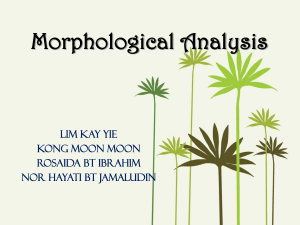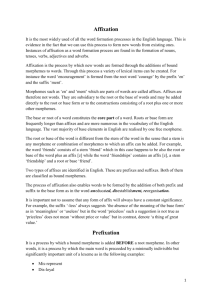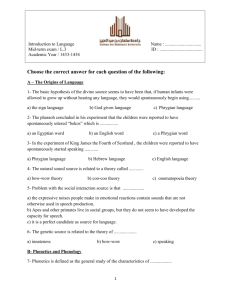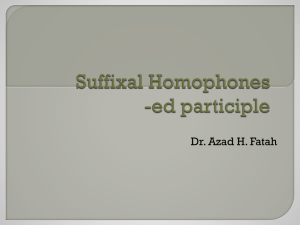The linguists traditionally view inflection and derivation as two
advertisement
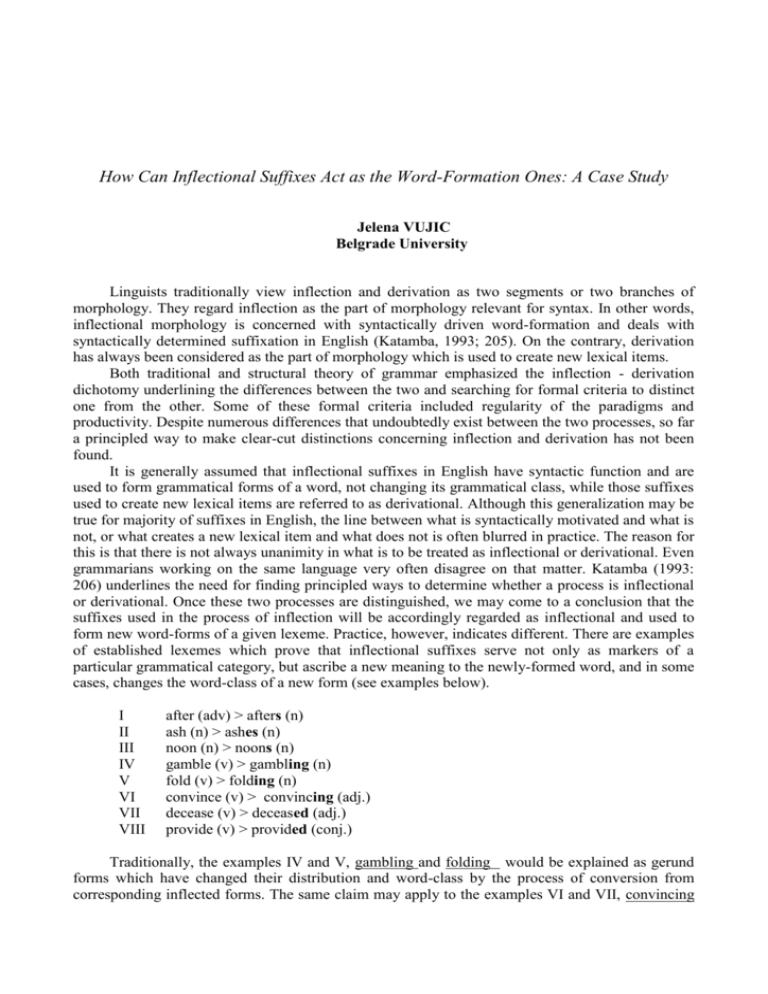
How Can Inflectional Suffixes Act as the Word-Formation Ones: A Case Study
Jelena VUJIC
Belgrade University
Linguists traditionally view inflection and derivation as two segments or two branches of
morphology. They regard inflection as the part of morphology relevant for syntax. In other words,
inflectional morphology is concerned with syntactically driven word-formation and deals with
syntactically determined suffixation in English (Katamba, 1993; 205). On the contrary, derivation
has always been considered as the part of morphology which is used to create new lexical items.
Both traditional and structural theory of grammar emphasized the inflection - derivation
dichotomy underlining the differences between the two and searching for formal criteria to distinct
one from the other. Some of these formal criteria included regularity of the paradigms and
productivity. Despite numerous differences that undoubtedly exist between the two processes, so far
a principled way to make clear-cut distinctions concerning inflection and derivation has not been
found.
It is generally assumed that inflectional suffixes in English have syntactic function and are
used to form grammatical forms of a word, not changing its grammatical class, while those suffixes
used to create new lexical items are referred to as derivational. Although this generalization may be
true for majority of suffixes in English, the line between what is syntactically motivated and what is
not, or what creates a new lexical item and what does not is often blurred in practice. The reason for
this is that there is not always unanimity in what is to be treated as inflectional or derivational. Even
grammarians working on the same language very often disagree on that matter. Katamba (1993:
206) underlines the need for finding principled ways to determine whether a process is inflectional
or derivational. Once these two processes are distinguished, we may come to a conclusion that the
suffixes used in the process of inflection will be accordingly regarded as inflectional and used to
form new word-forms of a given lexeme. Practice, however, indicates different. There are examples
of established lexemes which prove that inflectional suffixes serve not only as markers of a
particular grammatical category, but ascribe a new meaning to the newly-formed word, and in some
cases, changes the word-class of a new form (see examples below).
I
II
III
IV
V
VI
VII
VIII
after (adv) > afters (n)
ash (n) > ashes (n)
noon (n) > noons (n)
gamble (v) > gambling (n)
fold (v) > folding (n)
convince (v) > convincing (adj.)
decease (v) > deceased (adj.)
provide (v) > provided (conj.)
Traditionally, the examples IV and V, gambling and folding would be explained as gerund
forms which have changed their distribution and word-class by the process of conversion from
corresponding inflected forms. The same claim may apply to the examples VI and VII, convincing
and deceased, because it is a well-known fact that any form of present or past participle can
function as a noun modifier. The following examples illustrate this claim.Examples:
Gambling took place in this room.
His words were quite convincing.
No one seemed to know the deceased person.
Examples I, II, III and VIII, however, cannot be explained in a similar fashion. The
inflectional suffix –s used in noons (a light meal eaten at noon) afters (dessert) and ashes (human
remains), and the suffix –ed used in provided (on condition, if) certainly cannot be said to function
purely as markers of grammatical categories, as it is quite evident that they not only ascribe a new
meaning to the newly formed derivatives, but change their word-class and distribution as is the case
in examples I and VIII.
These examples may be regarded as a borderline between inflection and derivation. If these
two processes are to be totally polarized, then the examples provided here would fill the space
between the poles, bringing the two processes much closer. According to Bauer "word-formation is
such a confused area of study at the moment (and still is) that it would be hard to give an
uncontroversial account of it" (Bauer, 1983: xiii). One of the controversies of the modern English
morphology is the use of inflectional suffixes for creation of new lexemes, and the use of
derivational suffixes to mark some syntactic relations.
However, this phenomenon is not a novelty. Even Matthews noted that there are two possible
uses of inflectional and derivational affixes which contradict traditional definitions (Matthews,
1974: 53-54):
a) formative affixes can be used to mark grammatical categories. In other words, formatives
may be used as inflectional morphemes in creating new word-forms.
b) inflectional affixes may be used as derivational affixes for creating new lexemes.
In English the examples for a) would be the use of suffixes which add a feature [+feminine] to
certain nouns, such as suffixes –ina, -ette, -ess, thus serving as markers of the grammatical category
of gender.
Examples:
tzar (m) + -ina> tzarina (f)
usher (m) + -ette > usherette (f)
tiger (m) + -ess > tigress (f)
In the remainder of this paper we will try to provide some data to prove and support the b)
statement. For that purpose, a thorough study was conducted on the corpus of 1978 various
examples. Our findings proved that the most productive inflectional suffixes used for derivational
purposes are suffix -(e)s for plural of nouns, suffixes - ing , and –ed.
The examples studied were classified
a) according to the type of bases to which a particular suffix was added ( we do not use the
term “stem” here on a hypothesis that in particular examples collected for this study inflectional
suffixes are functioning as derivational);
b) according to the word-class of the derivative.
In that respect the total of 1978 examples were classified in 23 different subclasses:
1) N+-s >N; (e.g. jeans, noons, rags, golds, gums, waters, spectacles, corduroys, tweeds)
2) N+ -s >Adj; (e.g. bananas, nuts)
3) V+-s>N; (e.g. fries, eats, shivers, works, haves, speakies, remains)
4) Adj +-s>N; (e.g. blues, reds, hots, shorts, commons, simples, eatables)
5) Adv +-s>N; (e.g. insides, ins, afters, overheads)
6) Num+-s>N; (e.g. seconds, elevens, fives, teens,)
7) Pron + -s>N; (e.g. nothings, sundries)
8) V+ -ed> Adj; ( e.g. feigned, bereaved, jagged, plucked, orchestrated)
9) N+ -ed>Adj; ( e.g. gallused, headed, hooded, crooked, crested, foxed)
10) Adj+ -ed>Adj; (e.g. foliated)
11) V+ -ed>Adv; (e.g. confounded, damned)
12) V+-ed>N; ( e.g. betrothed, intended)
13) V+ -ed >Conj; (e.g. provided)
14) V+-ing>N; (e.g. clipping, breathing, acting, painting, advertizing)
15) N+ -ing>N; (e.g. salading, turtling, busing, suiting, dairying)
16) Adj +-ing> N; (e.g. greening, sweeting, whiting, wilding)
17) Adv+-ing>N; (e.g. inning, offing, outing)
18) V+-ing>Prep; ( e.g. saving, seeing, failing, including, pending)
19) V+ -ing> Conj; ( e.g. providing, supposing)
20) V+ -ing> Adv; (e.g. blooming, cracking)
21) V+ -ing>Adj; ( e.g. amusing, dashing, piping, roaring)
22) N+-ing>Adj; (e.g. flaming, blistering, carpetbagging, grueling)
23) Prep + -er> Adj. (e.g. outer, inner, upper)
While subtypes 1), 8), 14) and 21) show no violation of any morphological restriction, all the other
subtypes violate morphological constraints concerning the base to which suffixes are added, or the type
of the final derivative. If the meaning of the new forms is examined, the status of the morphemes {s},
{ed} and {ing} becomes questionable.
Let us start with the morpheme {s} which in our corpus proved to be the most productive of all,
809 examples being formed by –s suffixation. This morpheme is traditionally viewed as a
morphological marker of the grammatical category of number which adds the feature [+plural] to the
newly formed word. In other words, the morpheme {s} is presumed to have only grammatical meaning
denoting plural of nouns. As a result its use is restricted to nominal bases (stems), namely countable
nouns. Typically, the derivative is a countable noun, plural. If we go back to the examples from our
corpus it is evident that even the subtype 1), which seemed quite all right in the beginning, shows some
serious “deviation” from the rules. Firstly, the examples clearly indicate that morpheme {s} is not only
added to uncountable nouns, but ascribes a totally new meaning to the derivatives, i.e. the nouns from
our examples do not pluralize semantically. If we take a closer look at all the subtypes formed by the
means of suffix –s for plural, it is clear that the suffix inquestion is a denominal suffix. In six out of
seven subtypes of –s formations the result of such suffixation is a noun. The examples bananas and nuts
belonging to the subtype 2) N+ -s>Adj, may be regarded as adjectives converted from corresponding
plural forms of countable nouns.
In the corpus which we analyzed, the –ing formations represent the second largest group with
more than 500 examples. They were classified in nine different subtypes. Traditionally, morpheme
{ing} is viewed as a suffix added to verbal bases. The result of such suffixation is either a noun or a
modifier. In subtypes 15), 16),17) and 22) morphological rules regarding the type of base to which the
suffix –ing was added were broken, since the aforementioned suffix is added to nominal (subtypes 15)
and 22)), adjectival (subtype 16)) and adverbial (subtype 17)) bases. In most cases, the outcome of such
suffixation is a noun (except in subtype 22) where the derivative in question is a modifier). In 4 subtypes
( subtypes 14), 15),16) and 17) the suffix –ing is used to form nouns. The possibility that –ing may be
used as a formative morpheme to form nouns from substantives was noted by Marchand (1960; 241-
243). The analysis of some recent –ing formations proves that the combination N+-ing >N is
exceptionally productive morphological pattern in contemporary English (for more examples se
Hargraves: 2004, and McFedries: 2004).
In all the other subtypes the morpheme{ing} is added to verbal bases and everything seems in
order. However, if we are to determine the word-class of such suffixed forms we see that in subtypes 18)
and 19) suffix ing is used as a prepositional and conjunctional suffix, which clearly violates traditional
view that -ing is used to form substantives and modifiers.
As it was mentioned earlier in this paper, the problem of the status of {ed} morpheme has
received a good deal of attention (see Matthews :1974; Beard: 1976;Allen: 1978; Lieber: 1980;
Scalise; 1984;). The problem of –ed adjectives is well-known and has been a bone of contempt for
years among scholars who proposed different explanations for the phenomenon in question. Some
suggested that adjectival –ed and participle –ed cannot be regarded as one suffix the first being
formative (marking the change of a verb into a participial adjective) and the second inflectional
(marking the past participle form of a verb, see Marchand:1960; Beard:1976). Others argued that it
is the same suffix just changing its role (Nesfield:1956; Partridge: 1963; Hirtle:1970; Firth:1951).
In the corpus that was studied for this purpose morpheme {ed} proved to be highly productive,
though quite surprisingly less productive than morphemes {s} and {ing}. The number of examples
which belong to –ed formations is 403 and they are classified in six subtypes. In four subtypes the suffix
–ed is added to verbal bases. Unsurprisingly, the results of combination V+-ed are adjectives (subtype
8)), but quite surprisingly, adverbs in the subtype 11), nouns in the subtype 12) and conjunctions in the
subtype 13). In all those subtypes the morpheme –ed has the features [+inflectional, +derivational].
Some may argue that in these subtypes the nouns, adverbs and conjunctions are converted from
corresponding forms of past participles, in which case the nature of the morpheme {ed} remains
inflectional.
Even if we accept the claim that –ed formations that are nouns, adjectives and conjunctions are
actually converted forms it may be true for the subtypes 11), 12) and 13). However, subtype 9) N+-ed
>Adj questions the status of {ed} morpheme. In formations of this type the morphological restraint
concerning the type of base to which {ed} may be added is violated. This type of -ed formation is
anything but a novelty, but in such formations the status of –ed formative certainly cannot be [+
inflectional, +derivative] but rather
[-inflectional, +derivative], since it does not act as a
marker of past participle forms. It acts as an adjectival suffix.
Quite unusual is the subtype 10) Adj+-ed >Adj because in such a case –ed is hardly a derivational
suffix, as it does not change the word-class of the adjectival base, nor can it be regarded as an
inflectional since it does not act as a marker of any grammatical form. This subtype just complicates
matters further and adds to the confusing status of the morpheme {ed}.
As far as the morpheme {er} is concerned, the examples listed in 23) are the only ones that we
were able to find. The morpheme is a morpheme whose usage is restricted to adjectives, usually marking
the grammatical category of degree (comparative) in adjectives. In our examples it is used to form
adjectives from prepositional adverbs, in other words morpheme {er} changed the word-class of a base.
In such a confusion of things, in our corpus we resorted to the semantic-driven approach hoping
that it could assist us to clarify the status of the three morphemes in question. However, it was of little
help. We did manage to classify some example within some subtypes according to the specific meaning
that the certain morpheme ascribes which we illustrate in the following examples:
Examples:
a)
suit (n) >suiting (n)
trousers(n)> trousering(n)
shirt (n) > shirting(n)
b)
turtle (n) > turtling (n)
ice-boat (n) > ice-boating (n)
dairy (n) > dairying (n)
c)
corduroy (n)> corduroys (n)
tweed (n) > tweeds(n)
denim (n) > denims(n)
d)
hood (n) > hooded (adj.)
heart (n) > hearted (adj.)
ivy (n) > ivied (adj.)
In the examples a) the morpheme {ing} definitely adds the features [+ mass, -countable] to the
newly formed words whose meaning may be paraphrased as “the material used for making X” (X being
the noun serving as a base). In the examples in b) the same morpheme adds the features [-countable, +
abstract] to the newly formed words, thus changing the class of nouns serving as a base. The meaning of
the new forms may be paraphrased as” the action that is somehow connected to or involves X”.
In the examples c) the morpheme {s}adds the feature [+ concrete, + plural] to the newly formed
nouns at the same changing the class of nominal bases (mass nouns become concrete), and their number
(uncountable singular – singularia tantum becomes uncountable plural, pluralia tantum). The meaning
which the suffix –s attributes to the new forms is “ the trousers made from X”.
Semantically viewed the morpheme {ed} in the examples d) attributes the meaning “being
supplied with X”. We feel, however, that all the –ed adjectives, irrespective of the type of base from
which they are formed, bear a sort of passive meaning, which may lead us to conclusion that
derivational and inflectional –ed are indeed the same morpheme.
The examples in a), b), c) and d) represent just a handful of examples which allowed semantic
classification. In most cases, however, the meaning of the examples in the corpus is quite tentative and
idiosyncratic, which is no obstacle for productivity of inflectional morphemes in word-formation
processes in English (for some recent examples see Hargraves: 2004; and McFedries: 2004). What could
be concluded with certainty, on the other hand, is that new lexemes, if content words, develop their own
paradigms, often completely independent from those of a corresponding base. If the new lexemes are
functional words then they change their distribution (see subtypes 13) and 19)).
To sum up, the examples analyzed in our corpus show that the difference between “inflectional”
and “derivational” use of formatives –s, -ed, and –ing is “ a cline rather than a dichotomy” (Katamba:
199 , 217).Most of the examples analyzed here are included in modern English dictionaries, therefore,
the lexicographers accept their independent status.
What our study proved though, is that derivation and inflection are basically the same, rather than
qualitatively different and that their nature is simply a reflection of syntactic relevance. We may
legitimately raise the question whether in cases when the formatives in question manifest both
inflectional and derivational properties, inflection and derivation act in a unison. The results of such
“joint effort” are new elements of English lexicon. And lexicon is “a prison which contains only the
lawless, and the only thing that its inmates have in common is their lawlessness” (Di Sculio and
Williams,1987: 3).
REFERENCES:
Allen, M. “Morphological Investigations”, doctoral dissertation, University of Connecticut, 1978
Bauer, L. English Word-formation, CUP, Cambridge, 1983
Beard R.E. “Once More on the Analysis of -ed Adjectives”, Journal of Linguistics,1976
________, “On the Question of Lexical Regularity”, Journal of Linguistics, 1-178, 1981
Di Sculio, A.M. and Williams, E., On Defining a Word, MIT Press, Cambridge, Mass., 1987
Firth, J.R. Papers in Linguistics, OUP, Oxford, 1951
Hargraves, O. New Words, OUP, Oxford, 2004
Hirtle, W.H. “-ed Adjectives Like ‘verandahed’ and ‘blue-eyed’”, Journal of Linguistics 6, 19-36,1970
Katamba, F. Morphology, St. Martin’s Press, New York, 1993
Lieber, R., “The Organisation of the Lexicon”, doctoral thesis, MIT, 1980
Marchand, H The Categories and Types of Present-day English Word-formation, Otto Harasowitz,
Wiesbaden, 1960
Matthews, P., Morphology: an Introduction to a Theory of Wordstructure, CUP, Cambridge,1974
McFedries, P. Word Spy: the Word Lover’s Guide to Modern Culture, Broadway Books, New York,
2004
Nesfield, J.C. English Grammar Past and Present, Macmillan, London, 1956;
Partridge, E. Origins,3rd ed., Routledge & Keegan Paul, London, 1963
Scalise, A., Generative Morphology, Mouton, The Hague, 1984



